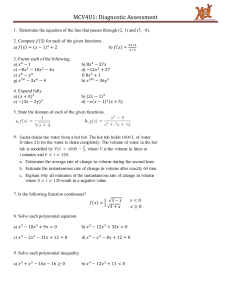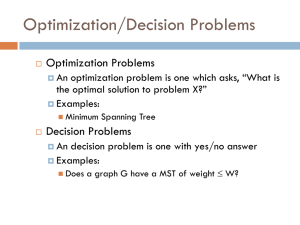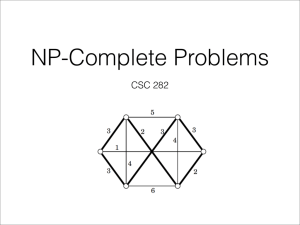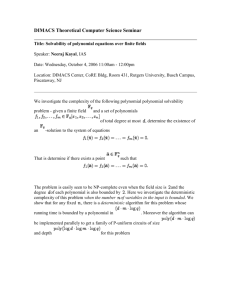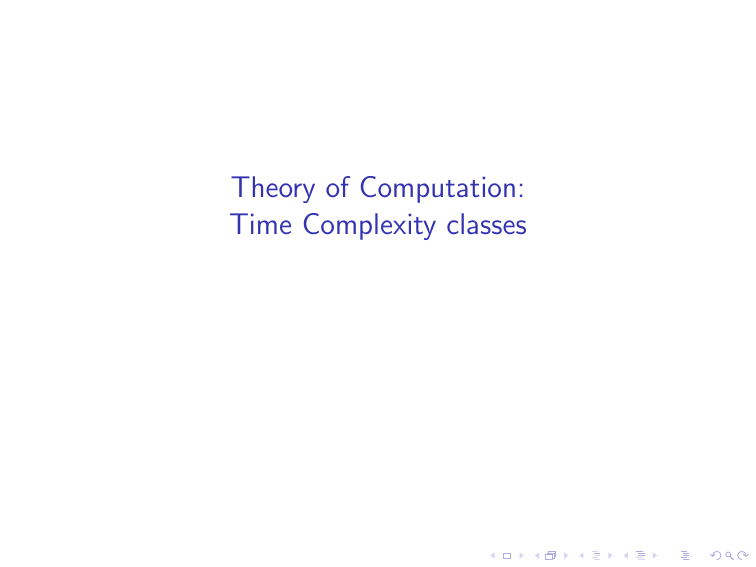
Theory of Computation:
Time Complexity classes
Complexity theory
Classify problems according to the computational resources
required to solve them. In this course:
Running time – time complexity
Storage space – space complexity
Attempt to answer: what is computationally feasible with
limited resources?
Complexity class: A set of functions that can be computed
within given resource bounds – could be time bounds/space
bounds.
Contrast with decidability – what is computable? But more
importantly we care about the resources.
Classification of Decision problems – we will briefly look at
why this is a good enough motivation to study complexity
theory. Search problems can be related to decision problems
in a natural way.
Central Questions
Is finding a solution as easy as recognizing one?
P = NP?
If I have a non-deterministic TM using polynomially many
cells to solve a problem, can I design a deterministic TM using
polynomially many cells to solve the problem?
PSPACE = NPSPACE
If I have a non-deterministic TM using f (n) many cells to
solve a problem, can I design a non-deterministic TM using
f (n) many cells to solve the complement problem?
Eg: NL = co-NL
Many more central problems – computer scientists have an
idea of what the answer should be but they do not have a
proof yet.
What are the consequences if one of the problems gets solved?
What happens if the answer is opposite to the widely held
beliefs?
Time complexity
DTIME: Let T : N → N be a function. A language L is in
DTIME (T (n)) if and only if there is a deterministic TM that
for some constant c > 0, given an n-length input runs in time
c · T (n) and decides L.
Recall that a deterministic TM on any given input can
proceed in exactly one way.
S
The class P: c≥1 DTIME (nc ). Thus the set of all problems
that can be solved in polynomial time.
The class P
Problems in P, Decision versions of:
Search algorithms
Sorting
BFS tree
DFS tree
Graph connectivity
Binary search
Nondeterminism
So far we considered decision problems, where algorithms were
designed in deterministic Turing Machines and where the total
running time was polynomial.
What happens if we introduce non-determinism?
Nondeterminism
Recall a simple problem: You are given a TM with an infinite
tape (infinite in both directions, but this is still equivalent to a
normal TM), where the tape head starts at a particular cell
with a special symbol ` (not used anywhere else on the tape),
and there is at most one cell that contains a 1 - all other cells
contain blanks. The aim is to design an algorithm to find if
there is a cell with a 1.
Let C be a cell with 1. Non-deterministic machine – will guess
in which direction C with 1 is and take time linear in the
distance between that cell and `.
Deterministic machine – will have to check in both directions.
If the distance between C and ` is n, then the deterministic
machine could take as much as O(n2 ) time.
If no such C exists – nondeterministic machine will guess that
no such cell exists.
The class NP
This class contains problems that can be verified in polynomial
time – as opposed to solved (class P).
If there is some form of evidence (certificate) given along with the
input itself, then a deterministic TM can be designed to verify if
the certificate indeed shows that the given instance is an instance
of the problem.
The class NP: Formal definition
A language L ∈ 0, 1∗ is in NP if:
there exists a polynomial p : N → N and
A polynomial time deterministic Turing Machine M
such that for every x ∈ 0, 1∗ ,
x ∈ L ⇐⇒ ∃u ∈ {0, 1}p(|x|) s.t M(x, u) = 1.
x ∈ L and u ∈ {0, 1}p(|x|) satisfies M(x, u) = 1: u is called a
certificate of x.
Example
Independent set: In a graph, an independent set I is a set of
vertices such that no pair in I have an edge between them.
Independent Set Problem: Given a graph G and an integer k,
is there an independent set of size st least k in G ?
Certificate: An independent set of size at least k in G !
Given a vertex set of the graph G , it is easy to verify whether
it is an independent set of size at least k. Hence this problem
is in NP.
NTIME
For every function T : N → N and L ⊆ {0, 1}∗ , L is said to be in
NTIME (T (n)) if there is a constant c > 0 and a NDTM M that
runs in c · T (n)-time such that for every x ∈ {0, 1}∗ ,
x ∈ L ⇐⇒ M(x) = 1.
NP and NTIME
Theorem: NP =
S
c∈N NTIME (n
c ).
NP and NTIME contd.
Proof:
The main idea is that the sequence of nondeterministic
choices made by an accepting computation of an NDTM can
be thought to be a certificate that the input is in the language
and vice versa.
S
c
c∈N NTIME (n ) ⊆ NP: Suppose p is a polynomial and L is
decided by NDTM N with running time p(n).
For an x ∈ L consider the sequence of nondeterministic
choices in order to reach accept state t. The sequence has
length p(|x|) - can be thought of as a certificate.
Given the certificate let M a deterministic TM that simulates
N using the certificate - M is the verifier.
NP and NTIME contd.
Proof:
S
NP ⊆ c∈N NTIME (nc ): Suppose p is a polynomial and
L ∈ NP with certificate sizes bounded by p and deterministic
TM M as verifier.
For an x ∈ L design a NDTM N that runs in polynomial time
in the following way.
N nondeterministically guesses the certificate for x - the
certificate is of polynomial length, so polynomial guesses.
It then runs the polynomial time verifier M to verify using the
guessed certificate if x ∈ L.
Class EXP
S
nc
EXP = S
c>1 DTIME (2 ).
c
NEXP = c>1 NTIME (2n ) - problems that can be verified in
exponential time. It is to EXP what NP is to P.
P ⊆ NP ⊆ EXP
P ⊆ NP: If L is in P then there is a Turing Machine N
solving it. This can be thought of as a Turing machine with
the empty string as a certificate.
NP ⊆ EXP: Suppose L ∈ NP has certificates and defined by
the polynomial function p() and is verified by a machine M.
Then for an input x, design a TM that enumerates all
certificates in {0, 1}p(|x|) and then for each such certificate
runs the TM M.
There can be 2O(p(n)) certificates for an n-length input string.
EXP and NEXP
If EXP 6= NEXP, then P 6= NP
If P 6= NP then EXP = NEXP could still hold!
We assume that P = NP and show that then EXP = NEXP
c
Suppose L ∈ NTIME (2n ) recognized by a machine M. For
|z|c
each string z ∈ L create z12 : new language Lpad .
If z is an input of L, in a new TM N, we take an input z12
of Lpad . This makes the length of the input string
c
approximately 2|z| .
|z|c
N first tries to see if the input is of the form z12
extracts z. It runs M on z.
So, Lpad ∈ NP =⇒ Lpad ∈ P =⇒ L ∈ EXP.
and
|z|c
P 6= NP
It is widely believed that P 6= NP: there is a difference in
complexity of solving in polynomial time and verifying in
polynomial time.
Some techniques have been developed to determine which
problems are “hard” in NP: NP-completeness. It is believed
that if NP-complete problems are in P then NP = P.
Many intermediate classes have also been discovered under
the assumption of P 6= NP: Ladner’s theorem constructs a
language that is neither in P nor is NP-complete.
The class coNP
coNP = {L|L ∈ NP}. A language L ∈ 0, 1∗ is in coNP if:
there exists a polynomial p : N → N and
A polynomial time deterministic Turing Machine
such that for every x ∈ 0, 1∗ ,
x ∈ L ⇐⇒ ∀u ∈ {0, 1}p(|x|) s.t M(x, u) = 1.
P ∈ NP ∩ coNP! If P = NP then NP = coNP!
Hard problems in NP: NP-Completeness
A language L ⊆ {0, 1}∗ is polynomial-time Karp reducible to a
language L0 ⊆ {0, 1}∗ , denoted by L ≤p L0 , if there is a
polynomial-time computable function f : {0, 1}∗ → {0, 1}∗ such
that for every x ∈ {0, 1}∗ , x ∈ L if and only if f (x) ∈ L0 .
We say that L0 is NP-hard if L ≤p L0 for every L ∈ NP. L0 is
NP-complete if L0 os NP-hard and L0 ∈ NP.
Karp Reductions
Properties of reductions
Theorem:
1. (Transitivity) If L ≤p L0 and L0 ≤p L00 , then L ≤p L00 .
2. If language L is NP-hard and L ∈ P, then P = NP.
3. If language L is NP-complete, then L ∈ P if and only if P = NP.
Properties of reductions
Proof:
If function p is O(nc ) and q is O(nd ). Composition function
p · q is O(ncd ) - also a polynomial.
1. If f1 is a polynomial-time reduction from L to L0 and f2 is a
polynomial-time reduction from L0 to L00 , then f2 · f1 is a
polynomial-time reduction from L to L00 such that
x ∈ L ⇐⇒ f1 (x) ∈ L0 ⇐⇒ f2 (f1 (x)) ∈ L00 .
Properties of reductions
Proof:
2. If L is NP-hard, then for all L0 ∈ NP there is a polynomial
time reduction to L. Now, if L ∈ P then there is a
deterministic TM M running in cp(n)-time, for some
polynomial p, such that L = L(M). Build a deterministic
polynomial time machine ML0 such that L0 = L(ML0 ): On
input x, first ML0 reduces it to an instance x 0 of L. Then it
runs M on x 0 and outputs the answer of M.
So NP ⊆ P ⊆ NP =⇒ P = NP
3. If L is NP-complete and L ∈ P then by its NP-hardness and
the previous point, P = NP.
If L is NP-complete and P = NP, then since L ∈ NP, L ∈ P.
NP-complete problems
Are there NP-complete problems?
NP-complete problems are problems in NP that are at least as
hard as any other problem in NP.
As seen above, if we can give a polynomial time algorithm for
an NP-complete problem, then we will solve P = NP (and win
1 million dollars!)
Boolean Formulas
Boolean formula φ: over a set of variables {u1 , u2 , . . . , un },
logical operators ∧, ∨, ¬.
Eg: (u1 ∧ u2 ) ∨ (u3 ∧ u4 ).
The set {u1 , ¬u1 , u2 , ¬u2 , . . . , un , ¬un } are called literals for
the Boolean formula.
Take z = (z1 , z2 , . . . , zn ) ∈ {0, 1}n . The string z is called an
assignment of φ: φ(z) denotes the evaluation of φ under the
assignment u1 = z1 , u2 = z2 , . . . , un = zn .
If ui = zi then ¬ui = 1 − zi (also denoted as ui ).
If φ(z) = 1 then z is a satisfying assignment of φ.
The size of a formula φ, denoted by |φ|, is the length of the
formula (in terms of the literals).
CNF formulas and SAT
CNF formula: Boolean formula of the form ∧i (∨j vij ), where
vij is either a variable uk or its negation uk .
Clause: (∨j vij ).
SAT: Determine if there is a satisfying assignment for an input
CNF formula φ.
A satisfying assignment has to satisfy each clause: so at least
one literal in each clause.
SAT is NP-complete
SAT ∈ NP: A satisfying assignment z is a polynomial length
certificate for the problem.
SAT is NP-hard by Cook-Levin Theorem:
For each input x of a language L ∈ NP accepted by a TM M,
a SAT formula φx is constructed based on the configurations
of M such that x ∈ L if and only if φx is satisfiable.
Suppose T : N → N is the function denoting the maximum
number of steps M executes on any instance - on input
instance x, the time taken is T (|x|).
If |x| = n, then |φx | is T (n) log n.
3-SAT is NP-complete
3-SAT: Each clause has at most 3 literals.
3-SAT in NP as it is a special case of SAT.
3-SAT is NP-hard as SAT ≤p 3 − SAT : For each CNF
formula φ we construct a 3-CNF formula ψ such that φ is
satisfiable if and only if ψ is satisfiable.
Take a clause C , say C = (`1 ∨ `2 ∨ . . . ∨ `k ), where `i s are
literals.
Delete C , introduce a new variable z
Introduce new clauses C1 = (`1 ∨ `2 . . . `k−2 ∨ z) and
C2 = (`k−1 ∨ `k ∨ z).
There is an assignment satisfying C if and only if there is an
assignment of {u1 , u2 , . . . , un } ∪ {z} that satisfies C1 ∧ C2
Repeat this strategy of reducing the size of clauses by
introducing new variables till all clauses have at most 3 literals
– this is ψ.
coNP-completeness:
coNP-completeness for language L ∈ coNP: Any language
L0 ∈ coNP is such that L0 ≤p L.
TAUTOLOGY = {φ|∀z ∈ {0, 1}n , φ(z) = 1}.
TAUTOLOGY is the complement language of SAT: in coNP.
SAT is NP-complete: For any language L ∈ NP, L ≤p SAT .
=⇒ L ≤p SAT = TAUTOLOGY .
TAUTOLOGY is coNP-complete.
